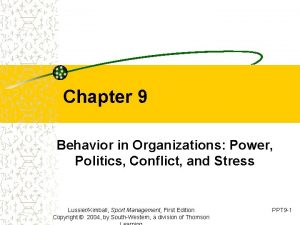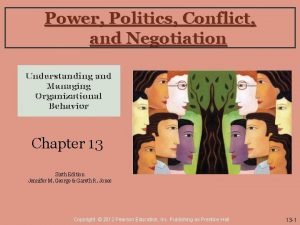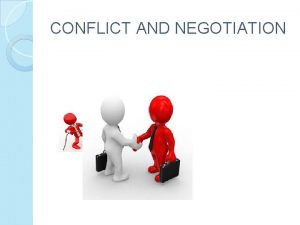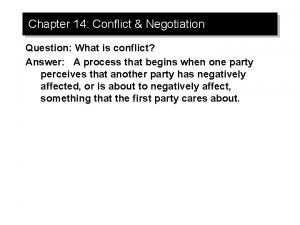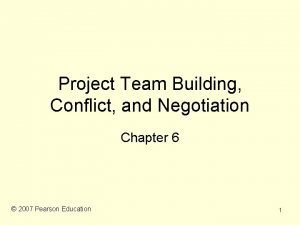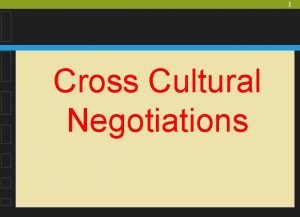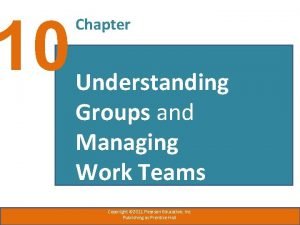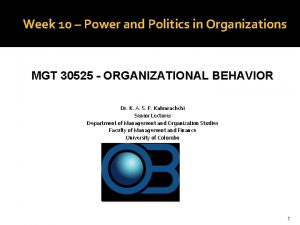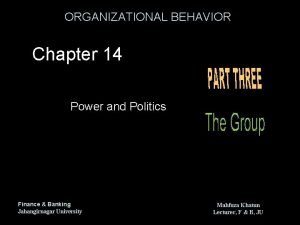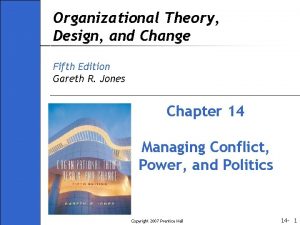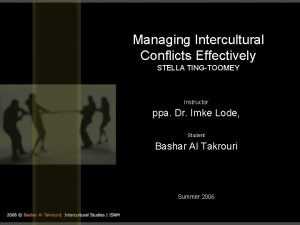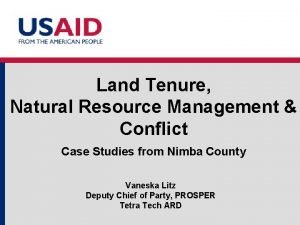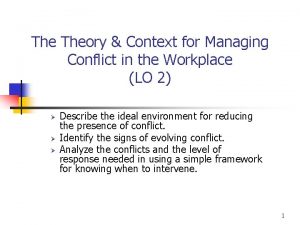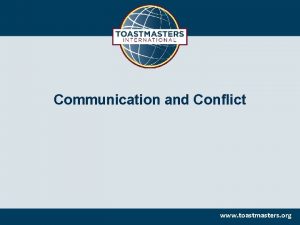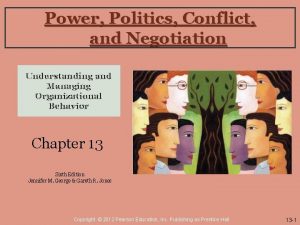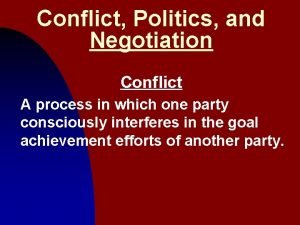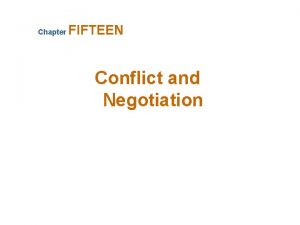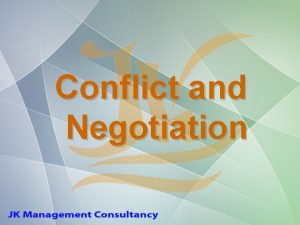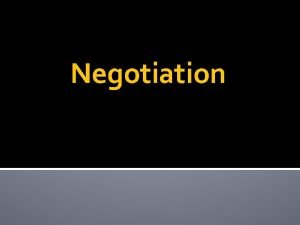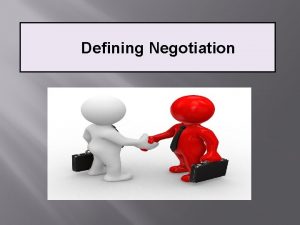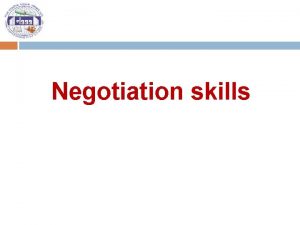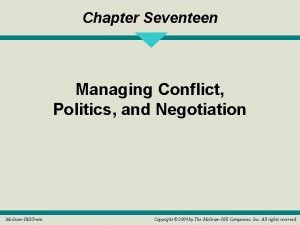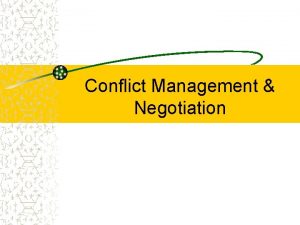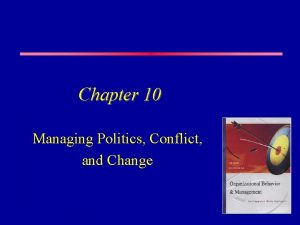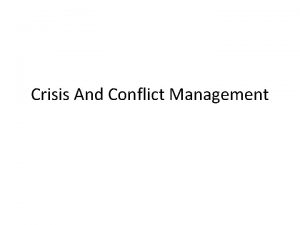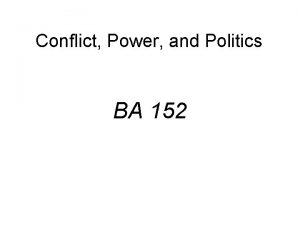Power Politics Conflict and Negotiation Understanding and Managing

























- Slides: 25

Power, Politics, Conflict, and Negotiation Understanding and Managing Organizational Behavior Chapter 13 Sixth Edition Jennifer M. George & Gareth R. Jones Copyright © 2012 Pearson Education, Inc. Publishing as Prentice Hall 13 -1

Learning Objectives Ø Understand the nature of power and explain why organizational politics exists and how it can help or harm an organization and its members Ø Differentiate between the main sources of formal and informal power people can use to engage in organizational politics as well as sources of functional and divisional power Copyright © 2012 Pearson Education, Inc. Publishing as Prentice Hall 13 -2

Learning Objectives Ø Discuss the nature of organizational conflict and the main sources of conflict in an organizational setting Ø Describe a model of the conflict process that illustrates how the conflict process works Ø Explain how negotiations can be used to manage the conflict process and resolve disputes between people and groups Copyright © 2012 Pearson Education, Inc. Publishing as Prentice Hall 13 -3

Using Power and Politics to Increase Performance Why do managers use their power to influence organizational performance? To keep up with competition Get better results Copyright © 2012 Pearson Education, Inc. Publishing as Prentice Hall 13 -4

The Nature of Power and Politics Power Ø Principal means of directing and controlling organizational goals and activities Ø Ability to get others to do something they might not otherwise do Copyright © 2012 Pearson Education, Inc. Publishing as Prentice Hall 13 -5

The Good Side of Power Ø Improve decision-making quality Ø Promote change Ø Encourage cooperation Ø Promote new organizational goals Copyright © 2012 Pearson Education, Inc. Publishing as Prentice Hall 13 -6

Sources of Individual Power Exhibit 13. 1 Individual Power Formal Power Legitimate power Reward power Coercive power Information power Informal Power Expert power Referent power Charismatic power Copyright © 2012 Pearson Education, Inc. Publishing as Prentice Hall 13 -7

A Power Struggle at Gucci Copyright © 2012 Pearson Education, Inc. Publishing as Prentice Hall 13 -8

Sources of Functional and Divisional Power Exhibit 13. 2 Ability to control uncertain contingencies Irreplaceability Centrality Ability to control and generate resources Functional or divisional power Copyright © 2012 Pearson Education, Inc. Publishing as Prentice Hall 13 -9

Organizational Politics Organizational politics are activities that managers engage in to increase their power. They can use the power to influence organizational decisions that favor their individual, functional, and divisional interests. Copyright © 2012 Pearson Education, Inc. Publishing as Prentice Hall 13 -10

Tactics for Increasing Individual Power Ø Tap sources of functional and divisional power Ø Recognize who has power Ø Control the agenda Ø Bring in an outside expert Ø Build coalitions/alliances Copyright © 2012 Pearson Education, Inc. Publishing as Prentice Hall 13 -11

Factors of Relative Power Sources of power Consequences of power Symbols of power Personal reputations Representational indicators Copyright © 2012 Pearson Education, Inc. Publishing as Prentice Hall 13 -12

Organizational Conflict Organizational conflict is the selfinterested struggle that arises when the goaldirected behavior of one person or group blocks the goal-directed behavior of another person or group Copyright © 2012 Pearson Education, Inc. Publishing as Prentice Hall 13 -13

The Effect of Conflict on Organizational Performance Exhibit 13. 4 Copyright © 2012 Pearson Education, Inc. Publishing as Prentice Hall 13 -14

Sources of Conflict Differentiation Task relationships Scarcity of resources Copyright © 2012 Pearson Education, Inc. Publishing as Prentice Hall 13 -15

Conflict Evolving from Task Relationships Overlapping authority Task interdependence Incompatible evaluation systems Copyright © 2012 Pearson Education, Inc. Publishing as Prentice Hall 13 -16

Pondy’s Model of Organizational Conflict Exhibit 13. 5 Stage 1: Latent Conflict Stage 2: Perceived Conflict Stage 3: Felt Conflict Stage 4: Manifest Conflict Stage 5: Conflict Aftermath Copyright © 2012 Pearson Education, Inc. Publishing as Prentice Hall 13 -17

Forms of Manifest Conflict Ø Open aggression Ø Violence Ø Infighting Ø Sabotage Ø Physical intimidation Ø Lack of cooperation Copyright © 2012 Pearson Education, Inc. Publishing as Prentice Hall 13 -18

OB Today: Fighting for Control at CIC Inc. Copyright © 2012 Pearson Education, Inc. Publishing as Prentice Hall 13 -19

Negotiation Initial Offer Compromise Counteroffers Concessions Copyright © 2012 Pearson Education, Inc. Publishing as Prentice Hall 13 -20

Individual-Level Conflict Management Ø Manager meets with employees in conflict; all understand facts of conflict Ø Manager summarizes dispute in written form Ø Manager discusses facts in report with each employee separately and works out a common solution Ø Manager gets commitment to resolving dispute Copyright © 2012 Pearson Education, Inc. Publishing as Prentice Hall 13 -21

Group-Level Conflict Management Ø Compromise Ø Collaboration Ø Accommodation Ø Avoidance Ø Competition Copyright © 2012 Pearson Education, Inc. Publishing as Prentice Hall 13 -22

Ways of Handling Conflict Exhibit 13. 6 High Collaboration Compromise Low Interest in helping others Accommodation Avoidance Competition Low High Interest in achieving individual goals Copyright © 2012 Pearson Education, Inc. Publishing as Prentice Hall 13 -23

Promoting Compromise Ø Emphasize common goals Ø Focus on the problem, not the people Ø Focus on interests, not demands Ø Create opportunities for joint gain Ø Focus on what is fair Copyright © 2012 Pearson Education, Inc. Publishing as Prentice Hall 13 -24

. This work is protected by United States copyright laws and is provided solely for the use of instructors in teaching their courses and assessing student learning. Dissemination or sale of any part of this work (including on the World. Wide. Web) will destroy the integrity of the work and is not permitted. The work and materials from it should never be made available to students except by instructors using the accompanying text in their classes. All recipients of this work are expected to abide by these restrictions and to honor the intended pedagogical purposes and the needs of other instructors who rely on these materials. All rights reserved. No part of this publication may be reproduced, stored in a retrieval system, or transmitted, in any form or by any means, electronic, mechanical, photocopying, recording or otherwise, without the prior written permission of the publisher. Printed in the United States of America. Copyright © 2012 Pearson Education, Inc. Publishing as Prentice Hall 13 -25
 Managing conflict and negotiation
Managing conflict and negotiation Power, politics and conflict in organizations
Power, politics and conflict in organizations Power, politics and conflict in organizations
Power, politics and conflict in organizations Managing negotiation
Managing negotiation Conflict and negotiation
Conflict and negotiation Negotiation in the workplace
Negotiation in the workplace Integrative vs distributive negotiation
Integrative vs distributive negotiation Negotiation team building
Negotiation team building Negotiation conflict styles by calum coburn
Negotiation conflict styles by calum coburn Understanding and managing clinical risk
Understanding and managing clinical risk Understanding groups and managing work teams
Understanding groups and managing work teams Finding and using negotiation power
Finding and using negotiation power Power and politics in organizations
Power and politics in organizations Contrasting leadership and power
Contrasting leadership and power Power and politics organization theory
Power and politics organization theory Power and politics
Power and politics The nature of power politics and government
The nature of power politics and government Political power definition
Political power definition Stress and conflict introduction
Stress and conflict introduction Power triangle
Power triangle Stella ting toomey
Stella ting toomey Mainwaring strategies for managing conflict
Mainwaring strategies for managing conflict Ways of managing conflict in the community
Ways of managing conflict in the community Managing conflict theory
Managing conflict theory Understanding conflict resolution toastmasters
Understanding conflict resolution toastmasters Whats external conflict
Whats external conflict

